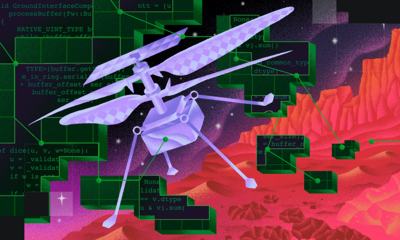| Open Source On Mars Acknowledged With A Badge |
| Written by Lucy Black | |||
| Tuesday, 20 April 2021 | |||
|
Ingenuity has made its maiden flight on Mars. It may only have lasted a few seconds, but signals an incredible achievement. It was done thanks to open source software and the nearly 12,000 developers who, mostly unknowingly, contributed to projects used now have the Mars 2020 Helicopter Mission badge on their GitHub profiles. Credit: GitHub blog After reporting on the successful arrival of the Perseverance Rover on Mars we have awaited news of its tiny companion, the Ingenuity drone helicopter. The size of a box of tissues and made from off-the-shelf electronic components its mission is to demonstrate that powered flight is a possibility in the thin atmosphere of Mars. It has been a nail-biting wait for MiMi Aung, Ingenuity's project manager, and her team at NASA's Jet Propulsion Laboratory in Pasadena, California. After completing all bar one of its preflight checks, it failed the final one - an attempt to spin its rotors to the rotational velocity they would achieve during operation flight - due to an issue with its watchdog timer. A software fix was devised and an adjustment to the command sequence was beamed from Earth to Mars and on April 19th Ingenuity made its first flight which consisted of taking off from the surface of Mars, achieving a height of about three meters, hovering for 40 seconds and returning safely to the surface. It used its on-board camera to photograph its own shadow while Perseverance videoed the event for posterity, as shown in this video from Space.com: Credit: Space.com In a news conference earlier this month Aung held out the prospect that the helicopter will go slightly higher and farther on its next two flights, getting up to 5 meters off the ground and moving a maximum of 50 meters downrange and if these flights are successful a further two sorties could be "really adventurous." What makes the historic flight so special for the developer community is the role played by open source software in this mission. Our previous report headlined Linux, but it is just one of many open source projects involved. The full list of around 60 projects used by JPL for Ingenuity is available on GitHub. It includes well known projects such as Python, SciPy, NumPy, MatPlotLib, OpenCV, Elasticsearch as well as F' (F Prime), the flight software and embedded systems framework originated by NASA. As Nat Friedman's post Open Source Goes To Mars explains developers who contributed to the specific version of any of the projects that made the first Martian flight possible - nearly 12,000 developers, automatically qualify for the Mars 2020 Helicopter Contributor badge, which has already been added to their profiles. Satya Nadella posted on Linkedin: A huge congratulations to NASA and to the thousands of developers whose open source contributions on GitHub helped make this historic mission a success.
More InformationNASA's Mars helicopter Ingenuity takes off (Space.com) Open Source on Mars: Community powers NASA’s Ingenuity Helicopter Related ArticlesLinux-Powered Ingenuity Lands On Mars Mars Curiosity Rover Gets A Software Update Help Curiosity Avoid Sand On Mars To be informed about new articles on I Programmer, sign up for our weekly newsletter, subscribe to the RSS feed and follow us on Twitter, Facebook or Linkedin.
Comments
or email your comment to: comments@i-programmer.info |
|||
| Last Updated ( Tuesday, 20 April 2021 ) |



